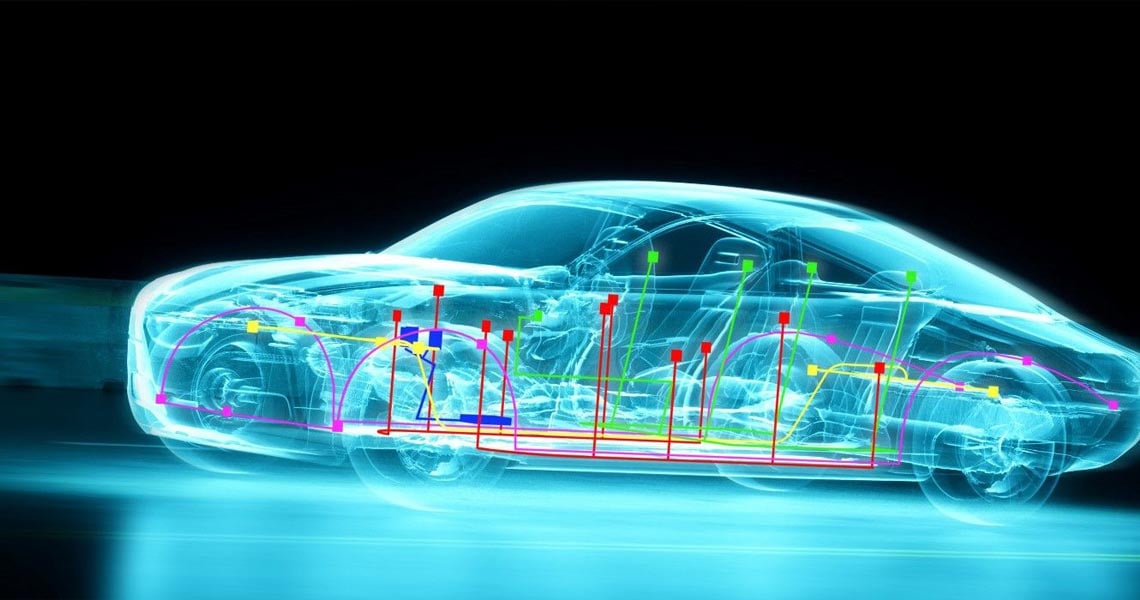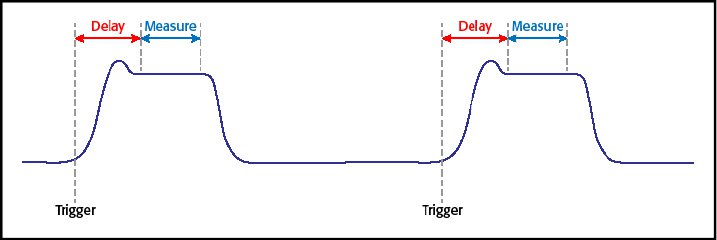
Kontaktaufnahme
Live-Chat mit Tektronix-Vertretern. Verfügbar von 9 bis 17 Uhr CET Geschäftstage.
Kontaktieren Sie uns telefonisch unter
Verfügbar von 9 bis 17 Uhr CET Geschäftstage.
Download
Laden Sie Handbücher, Datenblätter, Software und vieles mehr herunter:
Feedback
Exakt messende, rauscharme programmierbare Gleichspannungsnetzteile der Serie 2280S
Datenblatt der Serie 2280S
Weitere Informationen
- Keithley-Serie 2280S
- Produkt-Support
- Weitere Gleichspannungsnetzteil Modelle entdecken
Online lesen:
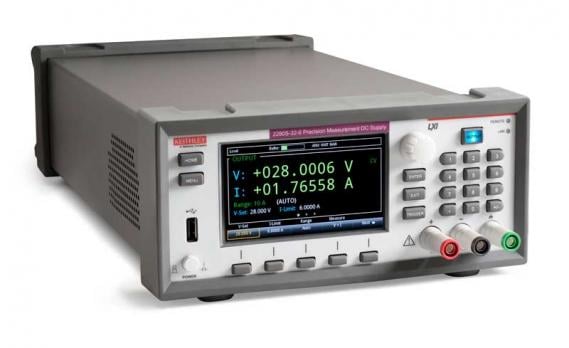
Die programmierbaren, rauscharmen DC-Netzteile der Serie 2280S für Präzisionsmessungen sind weit mehr als nur eine Quelle für sauberen Strom; sie sind auch Präzisionsmessinstrumente. Sie können stabile, rauscharme Spannungen liefern und Lastströme über einen breiten dynamischen Bereich von Ampere bis Nanoampere überwachen.
Das Modell 2280S-32-6 kann bis zu 32 V bei bis zu 6 A ausgeben; das Modell 2280S-60-3 kann bis zu 60 V bei bis zu 3,2 A ausgeben.
Beide Netzteile verwenden eine lineare Regulierung, um ein geringes Ausgangsrauschen und eine hohe Empfindlichkeit bei Laststrommessungen zu gewährleisten. Ein hochauflösender TFT-Farbbildschirm (Thin Film Transistor) zeigt eine Vielzahl von Informationen zu den Messungen an.
Softkey-Buttons und ein Navigationsrad bieten in Verbindung mit dem TFT-Display eine einfach zu bedienende Benutzeroberfläche, welche die Einrichtung und den Betrieb des Gerätes beschleunigt. Zudem ermöglichen integrierte Plot-Funktionen die Überwachung von Trends wie beispielsweise Drift. Dies ist einzigartig auf dem Gebiet der Labornetzteile.
Diese Netzteile bieten die Flexibilität, die sowohl für Tischgeräte als auch für automatisierte Testsysteme erforderlich ist. Sie bieten zum Beispiel einen Listenmodus, Trigger und andere Funktionen zur Geschwindigkeitsoptimierung, um die Prüfzeit in automatisierten Prüfanwendungen zu minimieren.
DMM-Qualität für Niederstrommessungen mit hoher Auflösung
Im Gegensatz zu herkömmlichen Stromversorgungen können die Geräte der Serie 2280S auch Messungen mit einer Auflösung von bis zu 6½ Stellen durchführen. Spannungsausgangsmessungen können auf bis zu 100µV aufgelöst werden. Diese Netzteile messen Lastströme von 100nA bis Ampere und können bis zu 10nA auflösen.
Vier Messbereiche für Lastströme (10 A, 1 A, 100 mA und 10 mA) ermöglichen die Messung des vollen Laststroms eines Gerätes, des Standby-Stroms und kleiner Ströme im Sleepmode mit einer Genauigkeit auf DMM-Niveau.
Die hohe Auflösung ermöglicht die zuverlässige Charakterisierung kleiner Änderungen der Lastströme. Außerdem ist es möglich, eine breite Auswahl an Messungen in einem einzigen Bereich mit ausgezeichneter Genauigkeit sowohl bei niedrigen als auch bei hohen Stromwerten durchzuführen.
Messung schnell wechselnder Lastströme
Erfassen Sie Messungen entweder mit einem externen Steuersignal oder dem Überschreiten eines analogen Schwellenwerts
Um schnell wechselnde und pulsartige Lastströme ordnungsgemäß zu überwachen, bieten die Stromversorgungen der Serie 2280S die erforderliche Geschwindigkeit, um Laständerungen zu erfassen, die in Intervallen von nur 140µs auftreten.
Mit dieser Fähigkeit können Entwickler und Hersteller von tragbaren, batteriebetriebenen Geräten die Lastströme in allen Betriebsarten eines Geräts problemlos überwachen und so den Gesamtstromverbrauch des Geräts ermitteln.
Diese Hochgeschwindigkeitsmessung ermöglicht die Erfassung jedes Zustands einer Einschaltlastsequenz und einer Ausschaltsequenz. Die Messungen können mit einer Geschwindigkeit von bis zu 2500 Messungen pro Sekunde durchgeführt werden, sodass die Stromaufnahme in jedem der Einschaltzustände charakterisiert und getestet werden kann.

Abbildung 1. Führen Sie zeitkritische Messungen an schnell wechselnden oder impulsartigen Lasten durch. Ein externer Trigger löst die Erfassung aus.
Durch programmierbare Verzögerungs- und Messzeiten sind Messungen zu einem bestimmten Zeitpunkt des Laststromimpulses möglich. Zusätzlich zum digitalen Trigger kann eine Schwellenwerteinstellung verwendet werden, um bis zu 2500 Messungen mit einer programmierten Abtastrate zu speichern.
Die Messungen können mit einer von zwei Methoden erfasst werden. Eine Messung kann durch ein digitales externes Steuersignal ausgelöst werden, das an den externen Eingang des digitalen I/O-Anschlusses übertragen wird.
Zusätzlich können bis zu 2500 Messungen mit einer Abtastrate von bis zu 2800 Messwerten pro Sekunde auf der Grundlage eines programmierten Schwellenwerts gespeichert werden. Der Anwender wählt sowohl das Niveau als auch die Steigung des Signals – entweder ein steigendes oder ein fallendes Signal.
Die Niveaueinstellung kann verwendet werden, um entweder Spannungs- und/oder Strommessungen zu speichern, wenn das Schwellenniveau überschritten wird. Wenn der Schwellenwert aktiviert ist, überwacht das Gerät kontinuierlich das Niveau des ausgewählten Parameters und speichert die Messungen zwischen.
Auf diese Weise können die Messungen vor dem Schwellenwert zusammen mit den Messungen nach dem Schwellenwert gespeichert werden.
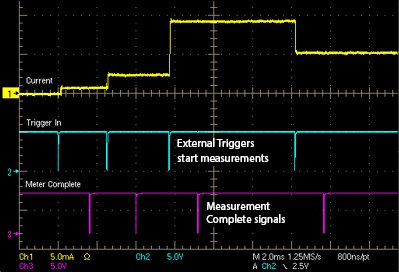
Abbildung 2. Messen Sie die Einschaltlastströme beim Einschalten eines Geräts.
Alle Parameter des Netzteils für maximale Leistung anzeigen und steuern
Das helle 4,3-Zoll-TFT-Display zeigt Spannungs- und Strommesswerte, die Quelleneinstellungen und viele weitere Einstellungen in großen, leicht lesbaren Zeichen an. Das auf Symbolen basierende Hauptmenü bietet alle Funktionen, die der Anwender steuern und programmieren kann, für einen schnellen Zugriff auf Quellenkonfiguration, Messkonfiguration, Anzeigeformate, Triggeroptionen und Systemeinstellungen.
Die Menüs sind kompakt, und die benötigten Menüoptionen sind leicht zu finden und klar beschrieben. So können Sie die Testparameter schnell mit dem Navigationsrad, dem Tastenfeld oder den Softkeys einstellen. Viele Konfigurationsparameter, zum Beispiel für Spannungs- und Stromeinstellungen, können direkt vom Startbildschirm aus eingegeben werden. Bei weniger komplexen Tests ist es nicht einmal erforderlich, das Hauptmenü aufzurufen, um Einstellungen vorzunehmen.
Unabhängig von der Komplexität Ihrer Testanforderungen bieten die Geräte der Serie 2280S eine einfache Möglichkeit, alle erforderlichen Parameter einzustellen.
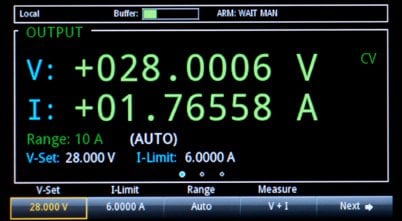
Abbildung 3. Stellen Sie Spannung, Strom, den Strombereich, den Messmodus, die Schutzstufen und andere Funktionen über den Startbildschirm ein.

Abbildung 4. Greifen Sie über das Hauptmenü auf die gesamte Funktionalität der Netzteile der Serie 2280S zu.
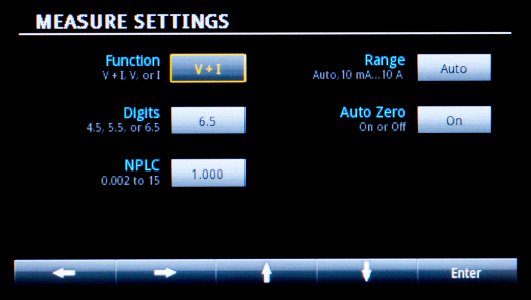
Abbildung 5. Konfigurieren Sie die Readback-Messungen exakt so, wie Sie sie benötigen, indem Sie einen Sub-Screen für Messungen verwenden.
Kontrollierte Anstiegs- und Abfallzeiten schützen die zu prüfenden Geräte
Arbeiten Sie an einem Gerät oder System mit einem hohen Einschaltstrom? Die Netzteile der Serie 2280S ermöglichen die Programmierung der Anstiegszeit des Spannungsausgangs, um die Spannungsrampe zu verlangsamen und ein Überschwingen der Spannung zu vermeiden, wodurch das Testobjekt möglicherweise beschädigt werden könnte.
Die Spannungsabfallzeit kann ebenfalls gesteuert werden, um ein schnelles Abfallen der Ausgangsspannung zu verhindern. Die Spannungsanstiegs- und -abfallzeiten können auf einen langsamen Wert von 10 V/s oder auf einen schnellen Wert von 100 V/s eingestellt werden. Kleine Spannungsübergänge können so programmiert werden, dass sie mit bis zu 1000 V/s ansteigen und abfallen.
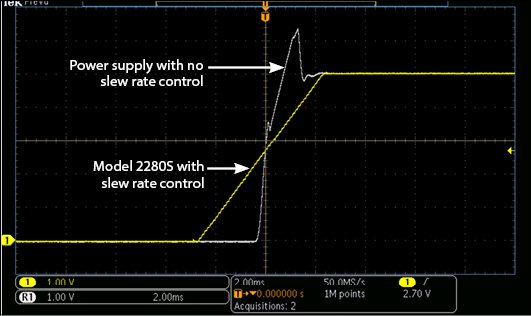
Abbildung 6. Programmierbare Anstiegsgeschwindigkeiten ermöglichen die Steuerung der Spannungsanstiegs- und -abfallraten und verhindern unerwünschte Transienten beim Einschalten kapazitiver Lasten.
Führen Sie teilautomatisierte Prüfungen direkt an Ihrem Arbeitsplatz durch
Testen Sie Ihren Entwurf automatisch über den gesamten Betriebsspannungsbereich oder untersuchen Sie, wie dieser auf Änderungen am DC-Ausgang reagiert, indem Sie die integrierte List-Mode-Funktion der Serie 2280S nutzen. Erstellen und speichern Sie bis zu 10 Listen mit aufeinanderfolgenden Spannungsniveaus, mit bis zu 99 verschiedenen Spannungen in jeder Liste.
Die Dauer jedes Spannungsniveaus kann auf einen Wert von 1 ms oder bis zu 60 s eingestellt werden. Erstellen Sie einfache lineare Rampen oder eine beliebige benutzerdefinierte Konfiguration über das Bedienfeld oder einen Schnittstellen-Bus. Ein einziger Trigger führt die Liste automatisch einmal oder mehrmals aus.
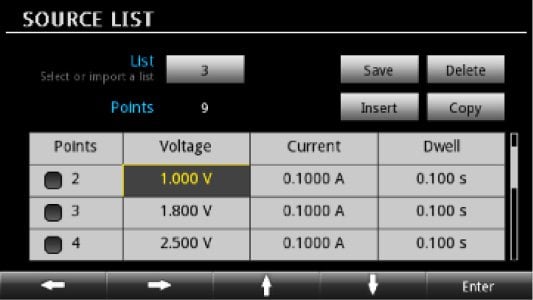
Abbildung 7A. Erstellen Sie eine Ausgabesequenz mithilfe des List-Setup-Bildschirms.
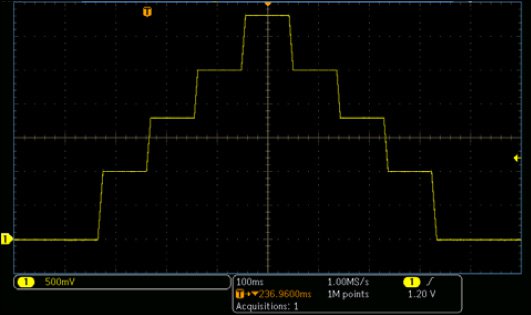
Abbildung 7B. Verwenden Sie den List-Modus, um die Ausgangsspannung automatisch durch eine Reihe von Stufen zu schalten. Die Spannungen wurden anhand der in Abb. 7A gezeigten Liste erstellt.
Trendanalyse und Charakterisierung des Laststroms
Verwenden Sie die integrierte Graphenfunktion, um die Stabilität des Laststroms zu überwachen oder einen dynamischen Laststrom zu erfassen und anzuzeigen. Sie können damit auch einen Laststrom beim Einschalten oder Ausschalten anzeigen. Die Netzteile der Serie 2280S können Messungen schnell durchführen und bis zu 2.500 Messpunkte speichern.
Zusätzlich zur Anzeige einer Spannungs- oder Stromkurve oder beiden, können sie Statistiken zu den gespeicherten Daten berechnen. Zu den statistischen Berechnungsoptionen gehören Mittelwert, Maximum, Minimum, Spitze-Spitze und Standardabweichung. Alle Informationen, die Sie benötigen, sind über einige wenige Anzeigemenüs zugänglich.
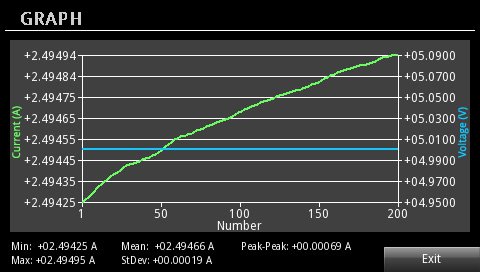
Abbildung 8. Überwachen Sie Spannung, Strom oder beides mit der Graphenfunktion.
Einfache, aber leistungsstarke Datenerfassung
Zusätzlich zur Erfassung von 2.500 Datenpunkten im internen Speicher und deren Anzeige mit der Graphenfunktion der Serie 2280S können Spannungs- und Strommessungen über die LAN-Schnittstelle und den integrierten Webbrowser der Serie 2280S erfasst werden. Die Startseite der Weboberfläche bietet eine Datenerfassungsoption.
Die Messungen können in einem programmierten Zeitintervall, auf der Grundlage einer programmierten Anzahl von Datenpunkten oder manuell über die Schaltfläche „Start/Stop“ auf der Benutzeroberfläche der webbasierten Oberfläche durchgeführt werden. Mit dem webbasierten Datenlogger können die Messungen kontinuierlich über mehrere Tage hinweg durchgeführt werden.
Abbildung 9 zeigt eine Webanzeige der Messungen, den Zeitpunkt der Messungen und eine Reihe von Statusparametern. Statistiken zu den erfassten Daten werden auf der Seite angezeigt und umfassen Maximum-, Minimum- und Mittelwerte.
Der gesamte Stromverbrauch in Milliampere-Stunden wird ebenfalls berechnet. Mit den Schaltflächen an der Seite des Bildschirmes können Sie die Datenaufzeichnung steuern und entweder ausgewählte Zeilen oder alle Daten kopieren.
Die Daten können zur Analyse einfach in einen Bericht oder ein Spreadsheet eingefügt werden. Verbinden Sie sich einfach über LAN mit einem Gerät der Serie 2280S und wählen Sie die Datenerfassungsoption. Diese leistungsstarke Funktion zur Datenerfassung erfordert keine Programmierung.
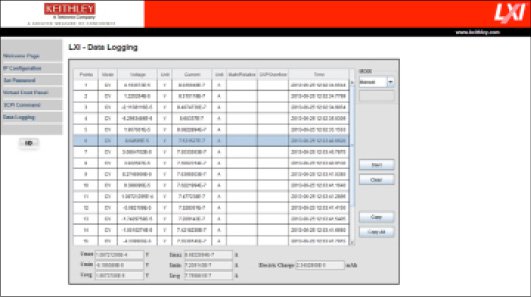
Abbildung 9. Webanzeige der LXI-Datenprotokollierungsfunktion mit allen gespeicherten Parametern und den zugehörigen Statistiken.
Automatisieren Sie einen Test schnell und einfach mit der KickStart-Software
Richten Sie mit der KickStart-Startup-Software in vier einfachen Schritten einen automatischen Test für die Netzgeräte der Serie 2280S ein. KickStart kann über einen kostenlosen Download über www.keithley.com auf Ihrem PC installiert werden.
Sobald das Programm gestartet wurde, führen Sie die folgenden Schritte aus: Erstellen Sie eine Testdatei, wählen Sie das Netzteil der Serie 2280S, wählen Sie die Netzgeräteanwendung und geben Sie die Testparameter ein. Führen Sie den Test aus und erhalten Sie Ergebnisse, ohne eine Zeile Programmcode schreiben zu müssen. KickStart bietet sowohl grafische als auch tabellarische Darstellungen.
Die Daten werden in der Testdatei gespeichert und können in Datenanalyseprogramme exportiert werden. Sie können auch einen Screenshot des Kurvenverlaufs für die Reproduktion in Prüfberichten aufnehmen. Bis zu 15.000 Datenpunkte können gespeichert werden. Möglicherweise ist KickStart die einzige Software, die Sie jemals benötigen.
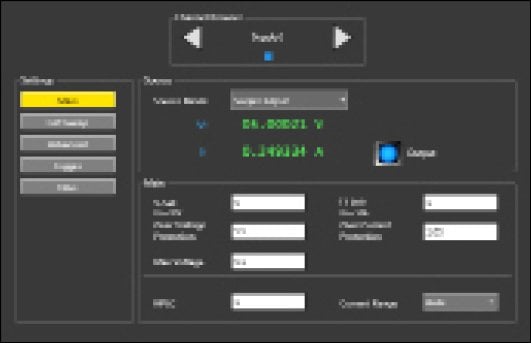
Abbildung 10. KickStart DC-Strom Hauptbildschirm.
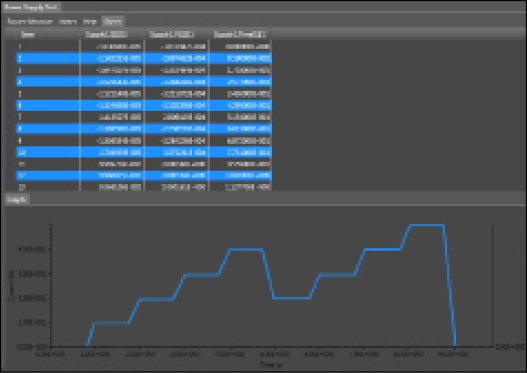
Abbildung 11. KickStart-Plot mit Messtabelle.
Optimierte Leistung für Produktionstests
Die Netzteile der Serie 2280S sind in einem Produktionstestsystem ebenso leistungsfähig wie flexibel auf dem Arbeitsplatz in der Forschung und Entwicklung. Neben der List-Mode-Funktion tragen mehrere weitere Merkmale der Serie 2280S dazu bei, die Prüfzeit in automatisierten Systemen zu minimieren.
Ein externer Triggereingang ermöglicht zum Beispiel die Hardwaresynchronisierung und die Steuerung durch andere Geräte im Prüfsystem. Um viele Systemverzögerungen zu eliminieren, erzeugen die Netzteile der Serie 2280S eine „Messung abgeschlossen“-Nachricht, die dem Testsystem signalisiert, dass die Netzteile ihre erforderlichen Aktionen abgeschlossen haben.
Um die Messzeit zu verkürzen, kann die Lesegeschwindigkeit erhöht werden. Hierzu wird die Erfassungszeit von der Integrationszeit des Stromnetzes, 16ms bei 60Hz (20ms bei 50Hz), auf 33μs (40μs) reduziert.
Außerdem können die Netzteile der Serie 2280S bis zu 0,45 A ableiten. Somit können diese Netzteile schnell eine gewisse Spannung entladen und auf eine andere Spannung wechseln.
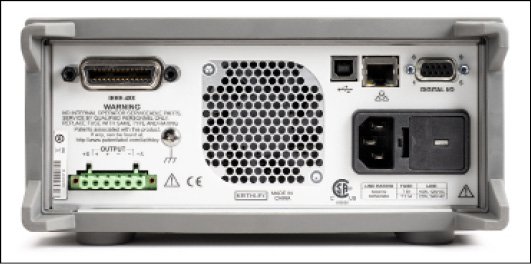
Abbildung 12. Die Rückseite der Serie 2280S zeigt den rückseitigen Ausgangsanschluss mit Remote-Sense-Eingängen, digitalen E/A und den drei Schnittstellen (GPIB, USB und LAN).
Eine Auswahl von Anschlüssen auf der Vorder- und Rückseite bietet eine erhöhte Anschlussflexibilität. Für maximale Spannungsgenauigkeit sorgt die 4-Leitermessung-, die sicherstellt, dass die programmierte Ausgangsspannung tatsächlich dem an der Last anliegenden Niveau entspricht. Außerdem werden die Messleitungen überwacht, um eventuelle Kabelbrüche zu erkennen.
Diese Funktionen stellen sicher, dass etwaige Produktionsprobleme schnell erkannt und korrigiert werden können. Vier zusätzliche digitale I/O-Anschlüsse können Fehlerstatusausgänge bereitstellen oder ein externes Relais oder eine Statuslampe steuern.
Die Netzteile der Serie 2280S können über ihre integrierten GPIB-, USB- oder LAN-Schnittstellen gesteuert werden. Die USB-Schnittstelle ist mit dem Test- und Messsystem (TMC) konform.
Die LXI-konforme LAN-Schnittstelle unterstützt die Steuerung und Überwachung einer Stromversorgung der Serie 2280S durch Fernzugriff. Dadurch können Testingenieure jederzeit auf das Netzteil zugreifen und Messungen einsehen, selbst wenn sie sich auf einem anderen Kontinent als ihre Testsysteme befinden.
Um die Entwicklung von Produktionsprüfsoftware zu erleichtern, stehen native National Instruments LabVIEW™-Treiber sowie IVI-C- und IVI-COM-Treiber auf der Keithley-Webseite unter www.tek.com zur Verfügung.
Technische Daten
23°C ±5°C mit 1-stündiger Aufwärmphase des Geräts.
DC-Ausgangswerte
|
2280S-32-6 |
2280S-60-3 |
|
|
Spannung |
0 bis 32 V |
0 bis 60 V |
|
Aktuell |
0 bis 6 A |
0 bis 3,2 A |
|
Max. Leistung |
192 W |
192 W |
Spannung 1
Quelleneinstellungen
|
2280S-32-6 |
2280S-60-3 |
|
|
Genauigkeit |
± (0,02 % + 3 mV) |
± (0,02% + 6 mV) |
|
Auflösung |
1 mV |
1 mV |
Messung2 (0,5 V Überbereich)
|
2280S-32-6 |
2280S-60-3 |
|
|
Genauigkeit |
± (0,02 % + 2 mV) |
± (0,02 % + 4 mV) |
|
Auflösung |
0, 1mV |
0, 1mV |
Zusätzlicher Offset bei schnelleren Messeinstellungen
|
2280S-32-6 |
2280S-60-3 |
|
|
5½ (0,1 PLC) |
0,21 mV |
0,40 mV |
|
4½ (0,01 PLC) |
1,44 mV |
2,7 mV |
|
3½ (0,002 PLC) |
7,60 mV |
14,25 mV |
Regulierung
|
2280S-32-6 |
2280S-60-3 |
|
|
Load (Laden) |
±(0,01 % + 2 mV) |
±(0,01 % + 2 mV) |
|
Netz |
±(0,01 % + 1 mV) |
±(0,01 % + 1 mV) |
Ausgangswelligkeit und Rauschen
|
2280S-32-6 |
2280S-60-3 |
|
|
Bandbreite 20 Hz – 20 MHz |
<1 m Veff |
< 2 mVRMS |
|
< 5 mV p-p |
< 7 mV p-p |
Lasttransienten-Erholungszeit: Widerstandslastwechsel von 50 % Last auf 100 % Last oder 100 % Last auf 50 % Last: <50 µs bis innerhalb von 15 mV der V-Einstellung.
Anstiegsgeschwindigkeit: Steigende Spannung und fallende Spannung: 10 V/s bis 100 V/s. Bis zu 1000 V/s unter eingeschränkten Bedingungen3. 100 V/s (Standard).
Maximaler Quellenspannungsabfall pro Leitung: Zur Aufrechterhaltung der angegebenen Spannungsgenauigkeit: 1 V.
Maximaler Leitungswiderstand von Sense HI und Sense LO: Zur Aufrechterhaltung der angegebenen Spannungsgenauigkeit: 2 Ω.
Aktuell
Einstellung der Stromgrenze
|
2280S-32-6 |
2280S-60-3 |
|
|
Vollskala-Ampere |
6 A |
3,2 A |
|
Genauigkeit |
±(0,05 % + 5 mA) |
±(0,05 % + 5 mA) |
|
Auflösung |
0,1 mA |
0,1 mA |
Messung 4 (120 % Überbereich außer 10 A)
|
Bereich |
Auflösung |
2280S-32-6 |
2280S-60-3 |
|
10 mA |
10 nA |
±(0,05 % + 10 µA) |
±(0,05 % + 10 µA) |
|
100 mA |
100 nA |
±(0,05 % + 10 µA) |
±(0,05 % + 10 µA) |
|
1 A |
1 μA |
±(0,05 % + 250 µA) |
±(0,05 % + 250 µA) |
|
10 A |
10 μA |
±(0,05 % + 250 µA) |
±(0,05 % + 250 µA) |
Zusätzlicher Offset bei schnelleren Messeinstellungen9
|
Messauflösung und (NPLC) |
Bereich |
2280S-32-6 |
2280S-60-3 |
|
5½ (0,1 PLC) |
10 mA |
5,0 µA |
5,0 µA |
|
100 mA |
20 µA |
20 µA |
|
|
1 A |
80 µA |
80 µA |
|
|
10 A |
2,0 mA |
2,0 mA |
|
|
4½ (0,01 PLC) |
10 mA |
20 µA |
20 µA |
|
100 mA |
40 µA |
40 µA |
|
|
1 A |
500 µA |
500 µA |
|
|
10 A |
10 mA |
10 mA |
|
|
3½ (0,002 PLC) |
10 mA |
30 µA |
30 µA |
|
100 mA |
250 µA |
250 µA |
|
|
1 A |
25 mA |
25 mA |
|
|
10 A |
75 mA |
75 mA |
Strompulsmessung 5
|
2280S-32-6 |
2280S-60-3 |
|
|
Minimale Pulsbreite (10 mA- und 100 mA-Bereich) 6 |
2,1 ms |
2,1 ms |
|
Minimale Pulsbreite (1 A- und 10 A-Bereich) 6 |
140 µs |
140 µs |
|
Mindestzeit zur Erfassung von zwei aufeinanderfolgenden Pulsen |
0,5 ms |
0,5 ms |
Regulierung
|
2280S-32-6 |
2280S-60-3 |
|
|
Load (Laden) |
±(0,01 % + 0,25 mA) |
±(0,01 % + 0,25 mA) |
|
Netz |
±(0,01 % ± 0,25 mA) |
±(0,01 % ± 0,25 mA) |
Ausgangswelligkeit und Rauschen
|
2280S-32-6 |
2280S-60-3 |
|
|
Bandbreite 20 Hz – 20 MHz |
< 3 mA RMS |
< 3 mA RMS |
Maximaler durchschnittlicher Dauersenkstrom
|
2280S-32-6 |
2280S-60-3 |
|
|
Nicht programmierbar |
0,45 A ± 15 % |
0,45 A ± 15 % |
System-Messgeschwindigkeiten
|
Einstellungen |
Gleichzeitig ( V+I ) |
Strom oder Spannung (I oder V) |
|||
|
Abtastungen/s |
Messauflösung und (NPLC) |
Autozero On 60 Hz (50 Hz) |
Autozero OFF 60 Hz (50 Hz) |
Autozero On 60 Hz (50 Hz) |
Autozero OFF 60 Hz (50 Hz) |
|
„Lesen?“ mit BUS-Übertragung |
6½ (5 PLC) |
2,0 (1,5) |
5,4 (4,5) |
2,5 (2,3) |
2,5 (2,3) |
|
6½ (1 PLC) |
9,0 (8,0) |
20 (18) |
11,5 (9,5) |
30,0 (28) |
|
|
5½ (0,1 PLC) |
48 (38) |
50 (48) |
50,0 (48,0) |
50,0 (48,0) |
|
|
„*TRG“ in den Speicher |
4½ (0,01 PLC) 7 |
440 (430) |
1915 (1820) |
||
|
3½ (0,002 PLC) 7 |
510 (510) |
2668 (2650) |
|||
Schutz
|
Überspannungsschutz (ÜSS) |
2280S-32-6 |
2280S-60-3 |
|
Einstellungsgenauigkeit |
± (0,25 % + 0,25 V) |
± (0,25 % + 0,5 V) |
|
Auflösung |
125 mV |
250 mV |
|
Ansprech- zeit |
6 ms (typisch)8 |
6 ms (typisch)8 |
|
Überstromschutz (OCP) |
2280S-32-6 |
2280S-60-3 |
|
Einstellungsgenauigkeit |
± (0,25 % + 0,10 A) |
± (0,25 % + 0,10 A) |
|
Auflösung |
25 mA |
12,5 mA |
|
Ansprech- zeit |
6 ms (typisch)8 |
6 ms (typisch)8 |
|
Überhitzungsschutz (OTP) |
2280S-32-6 |
2280S-60-3 |
|
Ausgangs-Abschalttemperatur |
>93°C (typisch) |
>93°C (typisch) |
|
Ansprech- zeit |
6 ms (typisch)8 |
6 ms (typisch)8 |
Weitere Timing-Daten
CV-zu-CC-Übergangszeit — (V-Set = 5 V, I-Limit = 0,5 A, Widerstandslaständerung 25 Ω zu 2,5 Ω): 2,4 ms.
CC-zu-CV-Übergangszeit (V-Set = 5 V, I-Limit = 0,5 A, Widerstandslaständerung 2,5 Ω zu 25 Ω: 1,1 ms.
Funktionswechsel (von der Erkennung des Busbefehls bis zum Abschluss des Funktionswechsels): 10 ms (typisch).
Output Off/On (von der Erkennung des Busbefehls bis zum Beginn des Spannungsabfalls): 5 ms (typisch).
Umpolungsaktivierung: 6 ms (typisch) 8.
Hinweise
- Die Spezifikationen basieren auf der Verwendung von Remote-Sense-Verbindungen. Bei 2-Draht-Verbindungen ist ein Offset von 0,5 mV/A (vordere Anschlüsse) hinzuzufügen.
- 6½-stellige Auflösung, 1 SPS-Leserate, Filter eingeschaltet, Autozero eingeschaltet.
- Anstiegs- und Abfallraten von 100 V/s bis 1000 V/s: 2280S-32-6: begrenzt auf 5 V-Änderungen bei maximal 3 A; zwischen 0 V und 5 V kann der Laststrom bis zu 6 A betragen, 2280S-60-3: begrenzt auf 10 V-Änderungen bei maximal 2 A; zwischen 0 V und 10 V kann der Laststrom bis zu 3,2 A betragen.
- 6-stellige Auflösung, 1 PLC Integrationszeit, Autozero: ein, Filter: ein 10 mA und 100 mA Bereiche: Quellenverzögerung: 2 ms, 1 A und 10 A Bereiche: Quellenverzögerung: 1ms.
- Einstellungen: Autozero: aus, 0,002 PLC, Auslösequelle: Extern, Triggerquelle: Sofort, Filter: aus 10 mA und 100 mA Bereiche: Quellenverzögerung: 2 ms 1A und 10 A Bereiche: Quellenverzögerung: 0 ms oder aus
- Die Zeit umfasst Triggererkennung, Jitter und 0,002 PLC-Integrationszeit.
- Einstellungen: Autozero: aus, Ausgangsverzögerung: aus, Quellenverzögerung: aus, Spannungsausgang ist konstant, Messanzahl: 1000.
- Zeit von der Erkennung der Bedingung bis zum Beginn der Ausgangsabschaltung.
- Filter ein, 10 mA und 100 mA Bereiche: Quellenverzögerung: 2 ms Bereiche 1 A und 10 A: Quellenverzögerung: 1 ms
Allgemein
Gleichtaktstrom: < 6 µA Spitze/Spitze.
Gehäuseisolierung: ± 240 V, jeder Anschluss zum Gehäuse. >1 GΩ parallel mit <6,8 nF.
Temperaturkoeffizient: Zu allen Genauigkeitsangaben außerhalb des Bereichs 23 °C ± 5 °C ist Folgendes hinzuzurechnen (0,15 × Spezifikation)/°C für 0° bis 18 °C und 28° bis 40 °C.
Messanzeige-Modi: Spannung und Strom, nur Spannung, nur Strom.
Steuerung der Messwerterfassung: Kontinuierlich, manuell, externer Digitaleingang, PC-Bus.
Listenmodus: — Maximale Anzahl der gespeicherten Listen: 9. Anzahl der Punkte in einer Liste: 2 – 99. Speicherort der Liste: Interner Speicher oder USB-Speicherstick.
Mathematik- und Filterfunktionen:
REL: Entfernt den Offset von der aktuellen Anzeigemessung, Bereich: –1×106 bis +1×106.
Mx+b: Messwert = x, M = –1×106 bis +1×106, b = –1×106 bis +1×106.
Filter: Gleitender Durchschnitt, Anzahl: 2–100, Fenster: 0,01 % bis 100 %.
Speicherpuffer:
2500 Speicherorte; jeder Speicherort enthält: Spannungsmessung, Strommessung, CV/CC-Modus und Zeitstempel, NVRAM.
Display: 4,3 Zoll. Farbdisplay an der Vorderseite, Auflösung: 480 Pixel × 272 Pixel.
Anzeige-Modi:
Spannungs- und Strommesswerte sowie Einstellungen in Echtzeit.
Darstellungen der gespeicherten Daten: Spannung vs. Datenpunkt, Strom vs. Datenpunkt, Spannung und Strom vs. Datenpunkt, 100-Punkt-Auflösung.
Diagramme können auch Statistiken anzeigen: Mittelwert, Maximum, Minimum, Spitze-Spitze-Wert, Standardabweichung.
Tabelle der gespeicherten Daten: Zeit/Datum, Spannung, Strom.
Soft-Button- und Navigationsrad-Steuerung.
Kommunikation:
GPIB: IEEE-488.2 konforme und Statusmodell-Topologie
LAN: RJ-45-Anschluss, 10/100BT, Auto-MDIX.
IP-Konfiguration: Statisch oder DHCP.
LXI Core 2011, Version 1.4,
USB: — USB 2.0-Gerät (Rückseite, Typ B), USBTMC-konform. Host (Frontseite, Typ A), Full Speed, unterstützt USB-Flash-Laufwerke.
Eingangsanschlüsse:
Vorderseite: (2-Draht). Verstellbare Unterstützung, Sicherheits-Bananenstecker, Gabelklemmen oder Draht.
Rückseite: (4-Draht-Messung). 6-Pin Schraubklemme, Sicherheitsabdeckung, abnehmbare Brücken für lokale Messung.
Echtzeituhr: Kapazitiv geladen, 20 Tage zwischen den nächsten Einschaltzyklen bei 23 °C und ≤50 % relativer Luftfeuchtigkeit (RH).
Digital I/O: 9-Pin Buchse, D-Sub. 6 Ein-/Ausgabe-Pins.
Eingangssignalpegel:
0,7 V (maximaler Logikpegel für Low)
3,7 V (maximaler Logikpegel für High)
Grenzwerte für die Eingangsspannung:
–0,25 V (absolutes Minimum).
+5,25 V (absolutes Maximum).
Maximaler Quellstrom: +2,0 mA@ >2,7 V (pro Pin).
Maximaler Senkstrom: –50 mA bei 0,7 V (pro Pin, mit Halbleitersicherung geschützt).
5 V-Netzteil, begrenzt auf 0,5 A bei >4 V (mit Halbleitersicherung geschützt)
Minimaler Impuls beim Triggereingang ≥4 µs, Logik-Low-Impuls
Messgerät-Bereitschaftsimpuls, 15–30 µs, Logik-Low-Impuls.
EMV: Konform mit der EMV-Richtlinie der Europäischen Union
Sicherheit:
US-NRTL-Zertifizierung: UL61010-1, 3. Ausgabe 2012 und UL61010-2-030:2012.
Kanadische Zertifizierung: CAN/CSA C22.2 No. 61010-1 3rd Ausgabe 2012.
EU-Konformität: Niederspannungsrichtlinie.
Kühlung: Zwangsbelüftung, seitliche Ansaugung und hintere Auslassöffnung.
Netzteil: 100V/120V/220V/240V ±10 %.
Netzfrequenz: 50/60 Hz ±3 Hz, wird beim Einschalten automatisch erkannt.
Leistungsaufnahme: 630 VA Spitze.
Betriebsumgebung: 0 ° bis 40 °C, ≤80 % relative Luftfeuchtigkeit bis 35 °C, nicht kondensierend. Höhe: bis zu 2000 Meter.
Lagerumgebung: –25 ° bis 70 °C.
LXI-Webbrowser-kompatibles Betriebssystem und Software: Windows 2000, Windows 7 und Windows XP kompatibel, unterstützt Webbrowser mit Java-Plug-in (erfordert Java-Plug-in 1.7 oder höher). Webseite, bereitgestellt von Modell 2280S
Rack-Abmessungen: (B×H×T), ohne Abdeckung: 213,8 × 88,4 × 383,3 mm (8,42 × 3,48 × 15,1 Zoll).
Gerätemaße: (B×H×T) mit Abdeckung: 255,3 × 107,2 × 415,0 mm (10,1 × 4,22 × 16,34 Zoll).
Versandgewicht: 13,29 kg (29,3 Pfund).
Nettogewicht: 10,85 kg (23,9 Pfund).
Garantie: 3 Jahre.
Bestellinformationen
2280S-32-6 DC-Netzteil für Präzisionsmessungen, 32 V 6 A
2280S-60-3 DC-Netzteil für Präzisionsmessungen, 60 V 6 A
Mitgeliefertes Zubehör
Schnellstart-Leitfaden
KickStart-Schnellstart-Leitfaden
CD mit Benutzerdokumentation
LAN Crossover-Kabel
Netzkabel
Rückseitiger Gegensteckverbinder und Abdeckung
VERFÜGBARES ZUBEHÖR
2280-TEST-LEAD-Netzteilprüfleitungssatz, 1000 V, 20 A Nennleistung
2280-001
CA-180-3A — Rückseitiger Gegensteckverbinder und Abdeckung
USB-B-1 USB-Kabel Typ A auf B, 1 m (3,3 ft) —
2450-TLINK — Trigger Link-Kabel zum Anschluss des 2280S Digital I/O an Trigger Link I/O anderer Keithley-Geräte
4299-8 Gestellbausatz mit Einfachbefestigung
4299-9 Gestellbausatz mit Zweifachbefestigung
4299-9 Gestellbausatz mit Zweifachbefestigung für ein 2U-Grafikdisplay und ein Gerät der Serie 26xx
4299-11 Duales festes Rack-Mount-Kit für ein 2U-Grafikdisplay-Gerät und ein Gerät der Serie 24xx, Serie 2000 oder ein 2U Agilent-Gerät
KPCI-488LPA — IEEE-488.2 Schnittstellenkarte für den PCI-Bus
KUSB-488B — IEEE-488.2 USB-GPIB-Schnittstellenadapter für USB-Anschluss mit 2 m (6,6 ft) Kabel
7007-05 Doppelt geschirmtes Premium IEEE-488 Schnittstellenkabel, 0,5 m (1,6 ft)
7007-1 Doppelt geschirmtes Premium IEEE-488 Schnittstellenkabel, 1 m (3,2 ft)
7007-2 Doppelt geschirmtes Premium IEEE-488 Schnittstellenkabel, 2 m (6,5 ft)
7007-3 Doppelt geschirmtes Premium IEEE-488 Schnittstellenkabel, 3 m (10 ft)
7007-4 Doppelt geschirmtes Premium IEEE-488 Schnittstellenkabel, 4 m (13 ft)


